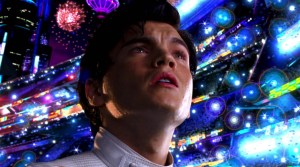
EDITOR’S NOTE: In the midst of the current pandemic, the comics industry has been brought to a standstill in a situation impacting creators, publishers, and many, local comic book stores. TKO Studios—a new publisher with an atypical business model—has pledged to send 50% of all purchases from their online store to the retailer of a customer’s choice. This offer provides much-needed relief for stores with no additional cost, while allowing readers to safely order TKO comics from inside their own homes. You can learn more about that offer here and select your own local comic book store to benefit after shopping for TKO titles here.
Videos by ComicBook.com
Even after reading Goodnight Paradise and finding myself thoroughly disappointed with the completed project, it remains a story I like a great deal in concept. The comic centers on Eddie, a homeless man surviving on the Venice Beach boardwalk, who discovers the murdered bodies of a young woman and her dog. It spirals outward into a plot encompassing homeless teenagers, local organized crime, and high stakes real estate deals. This conspiracy-fueled detective story packed with murder and deceit is a very familiar genre piece steeped in noir, but Eddie’s perspective—one shaken by decades of life on the outskirts of society combined with alcoholism—offers something new. Examining a complex mystery with a character ill-suited to solving it, but capable of providing a holistic view on this setting in which the American dream has collapsed altogether feels like a new and intriguing hook. Yet the completed Goodnight Paradise resembles a first draft of this pitch, something that can capably lure readers (or producers), but doesn’t offer much more than a competently crafted distraction while you turn the pages.

Goodnight Paradise utilizes TKO Studios’ “all at once” publication model to its advantage, pacing its story as a slow burn across all six issues, and treating the segments more like chapter breaks than individual units. The first issue primarily establishes Eddie’s perspective and setting, giving reader’s a sense of what it means to be homeless in the midst of so much warmth and wealth, with Eddie only discovering the murder at the very end. This introduction raises as many questions about writer Joshua Dysart’s narrative approach as it does about the mystery itself. However, questions about how Eddie’s unique mindset might influence his investigation or how the comics medium might be used to provide readers with their own unique understanding of the plot are quickly ignored. Later issues alter the comics’ perspective and indulge in exposition dumps to speed the story along. Some genre fare like Memento utilize an unreliable narrator to its advantage, but Goodnight Paradise often skirts its most engaging challenges and elements.
This would be easily forgiven if the plot of this mystery was the central draw of the comic, but that’s not the case. There are plenty of twists and turns in the conspiracy, with sufficient gory details and new murders along the way, but there’s nothing to make this particular noir-infused storyline stand out from its many predecessors. By the final issue, the resolution feels too pat in comparison to the mayhem that precedes it, with every loose end largely resolved.
Eddie’s role in the story is what makes Goodnight Paradise unique, but his own story and outlook are quickly made to submit to getting the facts of the case clearly across. His coherence and ability vary wildly, based more on the needs of the story than his own struggles with alcoholism and mental illness. It’s a sacrifice that adds unneeded clarity by sacrificing the most engaging element of the entire series.

The view of Venice Beach, and some familiar outlying areas, is never undermined though. Artist Alberto Ponticelli’s scratchy style pairs exceedingly well with the grim tone and tough circumstances of Goodnight Paradise, even if characters are sometimes rendered in a barely recognizable fashion. The aesthetic, geography, and mood of Venice Beach is clearly embedded in each issue. Whether it’s in the form of a splash page or background the sprawls into the horizon, this place and its conditions are made to feel real. There is careful attention to the variety of storefronts and unique history of this place, as well as the colors of summer in southern California summoned by Guilia Brusco. As a result, even when shortcuts are made in the narrative, it’s impossible to lose track of what makes this premise so attractive. Even the ugliest places are made to feel present and Venice Beach reads as a real place no matter a reader’s familiarity.
It’s this vision of Venice Beach that ultimately kept me reading Goodnight Paradise and the reason I can’t dismiss an effort at genre fiction that is simply serviceable in its plotting and method. The potential bound up in this place and concept are far greater than the comic they produced, but that potential also means that grappling with the story, including its many missteps, remains an engaging affair. It’s the sort of series that lures you back in to tinker with what could have been, and what could still be achieved in a sequel or adaptation. There’s enough value present in Goodnight Paradise that it still offers an amusing diversion in itself, while reminding readers that noir and comics should be capable of far more.
Rating: 3 out of 5
Published by TKO Studios
Written by Joshua Dysart
Art by Alberto Ponticelli
Colors by Giulia Brusco
Letters by Steve Wands








